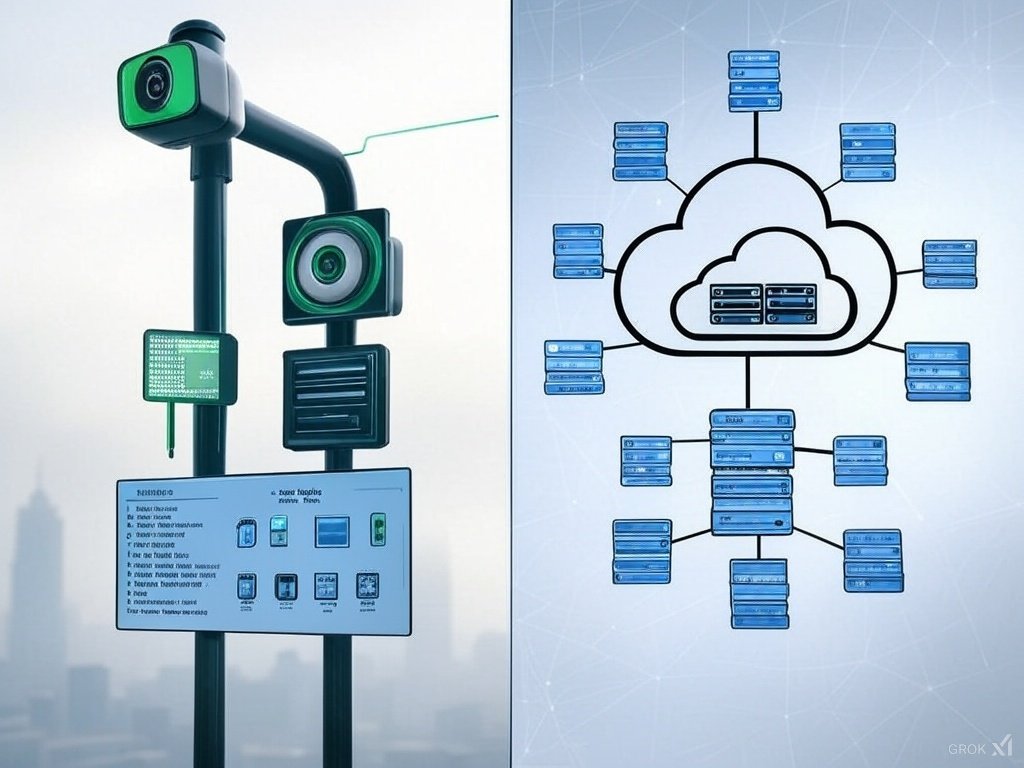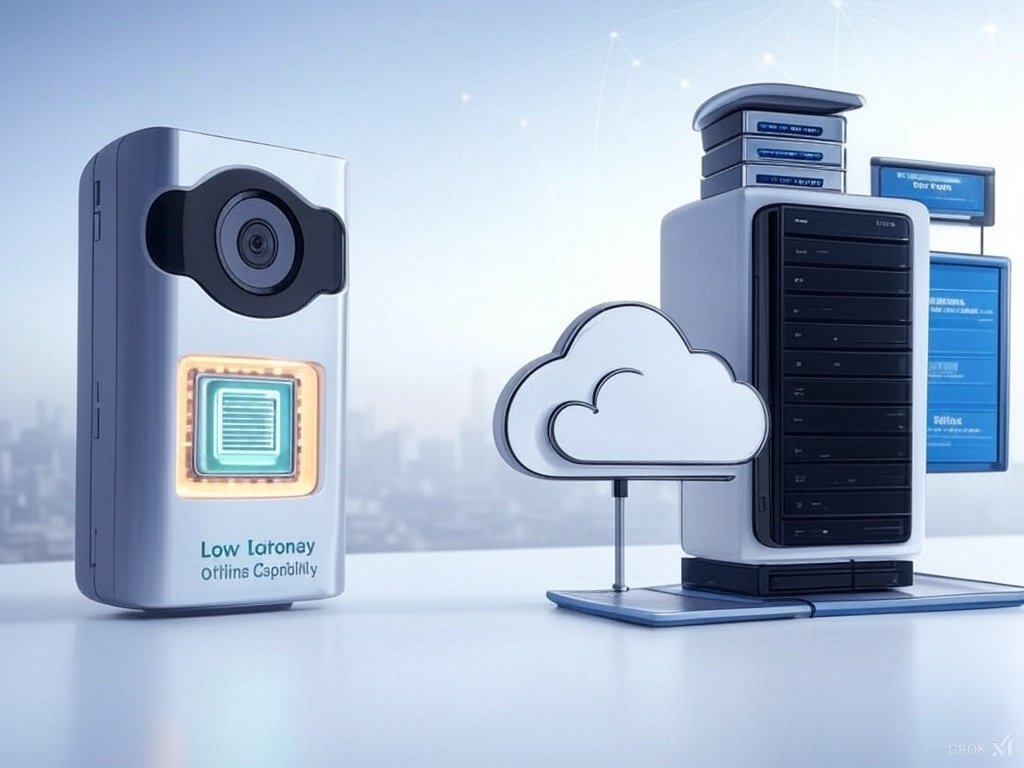IVA Architecture: Edge vs Cloud - The Ultimate Guide

Intelligent Video Analytics (IVA) is revolutionizing industries from security and surveillance to retail and manufacturing. At its core, IVA utilizes computer vision and machine learning to analyze video streams in real-time, extracting valuable insights and automating processes. However, the effectiveness of an IVA system heavily relies on its underlying architecture, specifically where the data processing takes place: on the edge or in the cloud.
Choosing between edge and cloud processing is a critical decision that impacts latency, bandwidth consumption, security, cost, and scalability. This blog post will delve into the nuances of each approach, providing a comprehensive comparison to help you determine the optimal architecture for your IVA deployment.
Understanding Edge Processing
Edge processing involves performing data analysis and processing directly on the device or local network where the video data originates. This typically involves deploying AI algorithms on edge devices such as smart cameras, on-site servers, or specialized edge computing platforms. The key benefit is reduced latency, as data doesn't need to travel to a remote data center for processing.
Benefits of Edge Processing for IVA
- Low Latency: Enables real-time analysis and immediate action, crucial for time-sensitive applications like security alerts and anomaly detection.
- Reduced Bandwidth Consumption: Processing data locally minimizes the amount of data transmitted to the cloud, saving on bandwidth costs and improving network efficiency.
- Enhanced Privacy and Security: Sensitive data can be processed and stored locally, reducing the risk of data breaches and compliance issues.
- Offline Operation: Edge devices can continue to function even without a constant internet connection, ensuring uninterrupted IVA capabilities.
- Scalability: Deploying processing power at the edge can improve overall system scalability.
Challenges of Edge Processing for IVA
While edge processing offers significant advantages, it also presents some challenges:
- Limited Processing Power: Edge devices typically have less processing power than cloud servers, which can limit the complexity of AI algorithms that can be deployed.
- Higher Upfront Costs: Deploying edge devices with sufficient processing capabilities can involve higher upfront hardware costs.
- Maintenance and Management: Managing and maintaining a large number of distributed edge devices can be complex and require specialized expertise.
- Security Vulnerabilities: Physical security of edge devices becomes a major concern.
- Limited storage: Local storage is often restricted on many edge devices.
Understanding Cloud Processing
Cloud processing involves transmitting video data to a remote data center where AI algorithms are executed on powerful servers. This approach leverages the virtually unlimited computing resources and scalability of the cloud, enabling complex AI models and centralized data management.
Benefits of Cloud Processing for IVA
- Scalability and Flexibility: Cloud platforms offer virtually unlimited computing resources, allowing you to scale your IVA system up or down as needed.
- Cost-Effectiveness: Cloud computing eliminates the need for upfront hardware investments and reduces ongoing maintenance costs through pay-as-you-go pricing models.
- Centralized Management: Cloud platforms provide centralized management tools for deploying, monitoring, and updating AI algorithms across your entire IVA system.
- Advanced Analytics: Cloud environments support complex AI models and big data analytics, enabling more sophisticated insights and predictions.
- Easy accessibility: Data and insights are accessible from anywhere with an internet connection.
Challenges of Cloud Processing for IVA
Despite its advantages, cloud processing also has its drawbacks:
- High Latency: Transmitting data to a remote data center introduces latency, which can be problematic for real-time applications.
- High Bandwidth Costs: Uploading large video streams to the cloud can consume significant bandwidth, leading to high costs.
- Privacy and Security Concerns: Storing sensitive data in the cloud raises privacy and security concerns, requiring robust security measures.
- Dependence on Internet Connectivity: Cloud-based IVA systems require a stable internet connection, which can be a limitation in areas with poor connectivity.
- Vendor Lock-in: Relying on a specific cloud provider can lead to vendor lock-in and limit flexibility.
Edge vs. Cloud: A Detailed Comparison
To make an informed decision, it's essential to compare edge and cloud processing across several key factors:
- Latency: Edge processing offers significantly lower latency than cloud processing, making it ideal for real-time applications.
- Bandwidth: Edge processing minimizes bandwidth consumption, while cloud processing requires substantial bandwidth for data transmission.
- Security: Edge processing can enhance privacy and security by keeping data local, while cloud processing requires robust security measures to protect data in transit and at rest.
- Cost: Edge processing involves higher upfront hardware costs but lower ongoing bandwidth costs, while cloud processing eliminates upfront hardware costs but incurs ongoing computing and bandwidth charges.
- Scalability: Cloud processing offers greater scalability and flexibility than edge processing, allowing you to easily scale your IVA system up or down as needed.
- Complexity: Edge processing can be more complex to deploy and manage due to the distributed nature of edge devices, while cloud processing offers centralized management tools and simplified deployment.
Hybrid Approach: The Best of Both Worlds
In many cases, the optimal solution involves a hybrid approach that combines the benefits of both edge and cloud processing. This entails performing some processing tasks on the edge to reduce latency and bandwidth consumption, while leveraging the cloud for more complex analytics, centralized management, and long-term data storage.
Examples of Hybrid IVA Architectures
- Real-time Alerting: Edge devices can perform basic object detection and trigger real-time alerts for security breaches, while the cloud can be used for more detailed analysis and forensic investigations.
- Traffic Management: Edge devices can count vehicles and monitor traffic flow in real-time, while the cloud can be used to analyze traffic patterns and optimize traffic light timings.
- Retail Analytics: Edge devices can track customer movements and dwell times in stores, while the cloud can be used to analyze sales data and optimize product placement.
Factors to Consider When Choosing an IVA Architecture
Selecting the right architecture for your IVA system depends on several factors:
- Application Requirements: Consider the latency, bandwidth, and security requirements of your specific IVA application.
- Network Infrastructure: Evaluate the available bandwidth and reliability of your network connection.
- Data Sensitivity: Assess the sensitivity of the video data and the potential risks associated with storing it in the cloud.
- Budget: Determine your budget for hardware, software, and ongoing operational costs.
- Scalability Needs: Estimate your future scalability needs and choose an architecture that can accommodate them.
- Technical Expertise: Consider the level of technical expertise required to deploy and manage the IVA system.
Best Practices for Implementing IVA Architectures
Regardless of whether you choose edge, cloud, or a hybrid approach, follow these best practices:
- Secure Your Devices and Data: Implement robust security measures to protect your edge devices and data from unauthorized access.
- Optimize AI Algorithms: Optimize your AI algorithms for performance and efficiency, especially when deploying them on edge devices with limited processing power.
- Monitor System Performance: Monitor the performance of your IVA system regularly to identify and address any issues.
- Choose the Right Hardware: Select hardware that is optimized for IVA workloads and provides the necessary processing power and memory.
- Regularly Update Software: Keep your software up to date to ensure that you have the latest security patches and bug fixes.

Future Trends in IVA Architectures
The field of IVA is constantly evolving, with several emerging trends shaping the future of IVA architectures:
- AI-Powered Edge Devices: Advancements in AI chips and embedded systems are enabling more powerful AI processing on edge devices.
- Federated Learning: Federated learning allows AI models to be trained on decentralized data without sharing the raw data itself, enhancing privacy and security.
- 5G Connectivity: The rollout of 5G networks is providing faster and more reliable connectivity for IVA systems, enabling new applications and use cases.
- Serverless Computing: Serverless computing allows you to run AI algorithms in the cloud without managing servers, simplifying deployment and reducing costs.
Choosing the right architecture for your Intelligent Video Analytics (IVA) system is a critical decision that impacts its performance, cost, and security. By carefully considering the factors outlined in this blog post, you can select the architecture that best meets your specific needs and maximizes the value of your IVA deployment. Whether you opt for edge, cloud, or a hybrid approach, remember to prioritize security, optimize your AI algorithms, and monitor system performance to ensure a successful IVA implementation.
As IVA technology continues to advance, staying informed about the latest trends and best practices is crucial for maintaining a competitive edge and achieving optimal results. The right architecture serves as the backbone for effective, efficient, and secure IVA implementations, enabling organizations to unlock the full potential of video analytics and drive meaningful outcomes.
Enjoyed this deep dive into IVA architectures? Give our GitHub project a star to show your support and stay updated on the latest advancements in AI and video analytics: Star our project on GitHub!